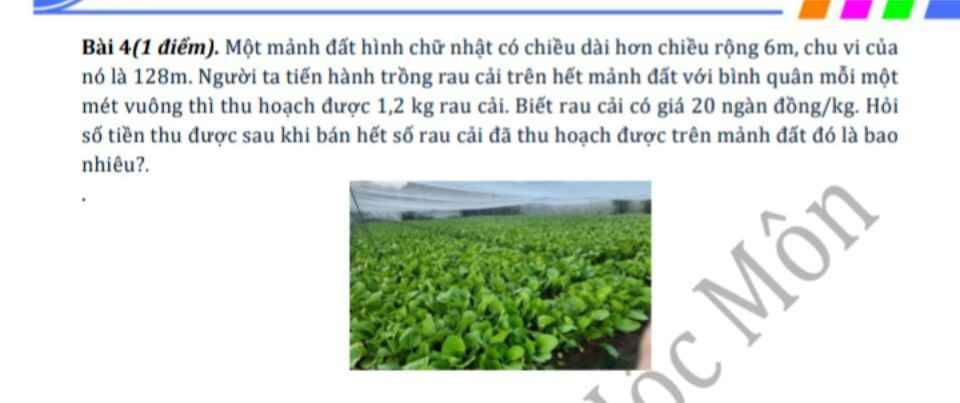 giúp tui
giúp tui
Hãy nhập câu hỏi của bạn vào đây, nếu là tài khoản VIP, bạn sẽ được ưu tiên trả lời.


Gọi a và b là số SP tổ 1 và tổ 2 sản xuất được trong tháng 1 (a, b>0)
Ta có: 0,15a + 0,12b = 1020 - 900 = 120
\(\Leftrightarrow12\left(a+b\right)+3a=12000\)
3a = 1200 \(\Rightarrow a=400\)
Vậy b = 900 - 400 = 500
KL: Trong tháng 1: tổ 1 làm được 400 SP; Tổ 2 làm được: 500 SP
Trong tháng 2: Tổ 1 làm được : 400 + 400.15% = 460SP
Tổ 2 làm được: 500 + 500.12% = 560SP
1 cách khác đưa về giải phương trình 1 ẩn đúng vs kiến thức lớp 8 .-
Gọi số sản phẩm của tổ 1 trong tháng 1 là x ( x > 0 )
Số sản phầm tổ 2 trong tháng 1 là 900 - x
Số sản phẩm trong tháng 2 của cả 2 tổ :
Tổ 1 : x + 15%x
Tổ 2 : 900 - x + 12% ( 900 - x )
Ta có phương trình
\(x+15\%x+900-x+12\%\left(900-x\right)=1020\)
\(\Leftrightarrow\dfrac{23}{20}x+\dfrac{28}{25}\left(900-x\right)=1020\)
\(\Leftrightarrow\dfrac{23}{20}x+1008-\dfrac{28}{25}x=1020\)
\(\Leftrightarrow\dfrac{3}{100}x=12\)
\(\Leftrightarrow x=400\)
Vậy số sản phẩm trong tháng 1 của tổ 1 là 400 , sản phẩm của tổ 2 = 900 - 400 = 500 ( sản phẩm )
Số sản phẩm trong tháng 2
Tổ 1 : 400 + 400.15% = 460 ( sản phẩm )
Tổ 2 : 1020 - 460 = 560 ( sản phẩm )
Làm theo cách Thầy Hùng sẽ nhanh hơn nhiều nhé

a, m\(x\) -2\(x\) + 3 = 0
Với m = -4 ta có :
-4\(x\) - 2\(x\) + 3 = 0
-6\(x\) + 3 = 0
6\(x\) = 3
\(x\) = 3 : 6
\(x\) = \(\dfrac{1}{2}\)
b, Vì \(x\) = 2 là nghiệm của phương trình nên thay \(x\) = 2 vào phương tình ta có : m.2 - 2.2 + 3 = 0
2m - 1 = 0
2m = 1
m = \(\dfrac{1}{2}\)
c, m\(x\) - 2\(x\) + 3 = 0
\(x\)( m -2) + 3 = 0
\(x\) = \(\dfrac{-3}{m-2}\)
Hệ có nghiệm duy nhất khi m - 2 # 0 => m#2
d, Để phương trình có nghiệm nguyên thì: -3 ⋮ m -2
m - 2 \(\in\) { - 3; -1; 1; 3}
m \(\in\) { -1; 1; 3; 5}


\(\dfrac{x+1}{59}+\dfrac{x+3}{57}+\dfrac{x+5}{55}=\dfrac{x+7}{53}+\dfrac{x+9}{51}+\dfrac{x+11}{49}\)
\(< =>\dfrac{x+1}{59}+1+\dfrac{x+3}{57}+1+\dfrac{x+5}{55}+1=\dfrac{x+7}{53}+1+\dfrac{x+9}{51}+1+\dfrac{x+11}{49}+1\)
\(< =>\dfrac{x+60}{59}+\dfrac{x+60}{57}+\dfrac{x+60}{55}=\dfrac{x+60}{53}+\dfrac{x+60}{51}+\dfrac{x+60}{49}\)
\(< =>\left(x+60\right)\left(\dfrac{1}{59}+\dfrac{1}{57}+\dfrac{1}{55}-\dfrac{1}{53}-\dfrac{1}{51}-\dfrac{1}{49}\right)=0\\ < =>x+60=0\\ < =>x=-60\)
Ta có : \(\dfrac{x+1}{59}+\dfrac{x+3}{57}+\dfrac{x+5}{55}=\dfrac{x+7}{53}+\dfrac{x+9}{51}+\dfrac{x+11}{49}\)
\(\Leftrightarrow\dfrac{x+1}{59}+\dfrac{x+3}{57}+\dfrac{x+5}{55}+3\text{=}\dfrac{x+7}{53}+\dfrac{x+9}{51}+\dfrac{x+11}{49}+3\)
\(\Leftrightarrow\left(\dfrac{x+1}{59}+1\right)+\left(\dfrac{x+3}{57}+1\right)+\left(\dfrac{x+5}{55}+1\right)\text{=}\left(\dfrac{x+7}{53}+1\right)+\left(\dfrac{x+9}{51}+1\right)+\left(\dfrac{x+11}{49}+1\right)\)
\(\Leftrightarrow\left(\dfrac{x+1}{59}+1\right)+\left(\dfrac{x+3}{57}+1\right)+\left(\dfrac{x+5}{55}+1\right)\text{=}\left(\dfrac{x+7}{53}+1\right)+\left(\dfrac{x+9}{51}+1\right)+\left(\dfrac{x+11}{49}+1\right)\)
\(\Leftrightarrow\dfrac{x+60}{59}+\dfrac{x+60}{57}+\dfrac{x+60}{55}\text{=}\dfrac{x+60}{53}+\dfrac{x+60}{51}+\dfrac{x+60}{49}\)
\(\Leftrightarrow\dfrac{x+60}{59}+\dfrac{x+60}{57}+\dfrac{x+60}{55}-\dfrac{x+60}{53}-\dfrac{x+60}{51}-\dfrac{x-60}{49}\text{=}0\)
\(\Leftrightarrow\left(x+60\right)\left(\dfrac{1}{59}+\dfrac{1}{57}+\dfrac{1}{55}-\dfrac{1}{53}-\dfrac{1}{51}-\dfrac{1}{49}\right)\text{=}0\)
\(Do\) \(\dfrac{1}{59}+\dfrac{1}{57}+\dfrac{1}{55}-\dfrac{1}{53}-\dfrac{1}{51}-\dfrac{1}{49}\ne0\)
\(\Leftrightarrow\left(x+60\right)\text{=}0\)
\(x\text{=}-60\)
\(Vậy...\)

\(\dfrac{1}{x+3}+\dfrac{8}{\left(x+1\right)\left(x-3\right)}=\dfrac{2x}{x^2-2x-3}\)
* x2 - 2x - 3 = x2- 3x + x - 3 = x(x-3 ) + ( x - 3) = ( x - 3 ) ( x + 1 )
\(\Leftrightarrow\dfrac{1}{x+3}+\dfrac{8}{\left(x+1\right)\left(x-3\right)}=\dfrac{2x}{\left(x-3\right)\left(x+1\right)}\left(ĐKXĐ:x\ne\pm3;x\ne-1\right)\)
\(\Leftrightarrow\left(x+1\right)\left(x-3\right)+8\left(x+3\right)=2x\left(x+3\right)\)
\(\Leftrightarrow x^2-2x+1+8x+24=2x^2+6x\)
\(\Leftrightarrow-x^2+25=0\)
\(\Leftrightarrow x^2-25=0\Leftrightarrow\left(x-5\right)\left(x+5\right)=0\)
\(\Leftrightarrow\left[{}\begin{matrix}x=5\\x=-5\end{matrix}\right.\)
Vậy \(S=\left\{-5;5\right\}\)

\(\dfrac{2x+1}{2x-1}-\dfrac{2x-1}{2x+1}=-\dfrac{6}{1-4x^2}\left(ĐKXĐ:x\ne\pm\dfrac{1}{2}\right)\)
\(\Leftrightarrow\left(2x+1\right)^2-\left(2x-1\right)^2=6\)
\(\Leftrightarrow4x^2+4x+1-\left(4x^2-4x+1\right)=6\)
\(\Leftrightarrow4x^2+4x+1-4x^2+4x-1=6\)
\(\Leftrightarrow8x=6\)
\(\Leftrightarrow x=\dfrac{6}{8}=\dfrac{3}{4}\)
Vậy \(S=\left\{\dfrac{3}{4}\right\}\)



Gọi chiều rộng của mảnh đất là x (m) với x>0
Chiều dài của mảnh đất là: \(x+6\) (m)
Do chu vi mảnh đất là 128m nên ta có pt:
\(2\left(x+x+6\right)=128\)
\(\Leftrightarrow4x+12=128\)
\(\Leftrightarrow x=29\)
Diện tích mảnh đất là: \(29.\left(29+6\right)=1015\left(m^2\right)\)
Số rau thu hoạch được: \(1015.1,2=1218\left(kg\right)\)
Số tiền thu được:
\(1218.20000=24360000\left(đ\right)\)